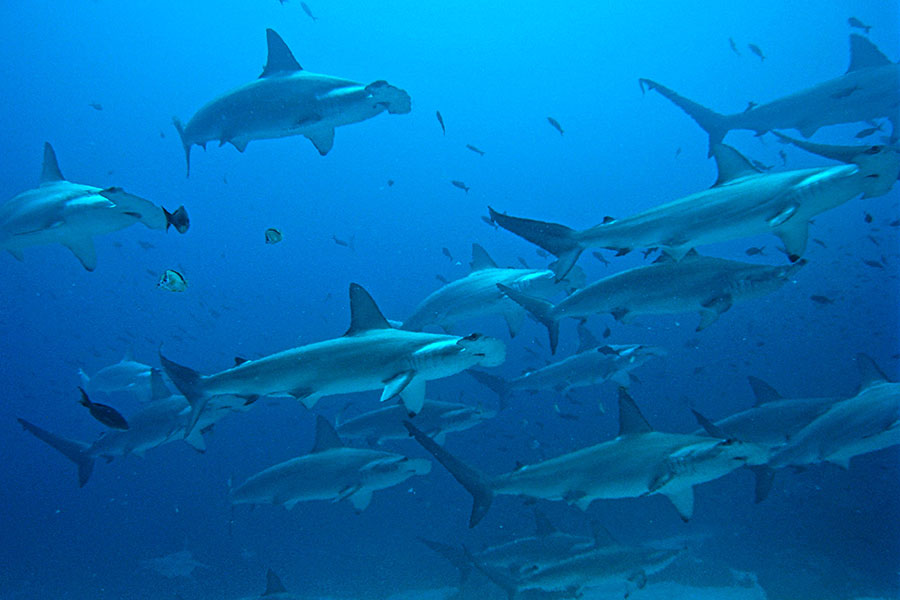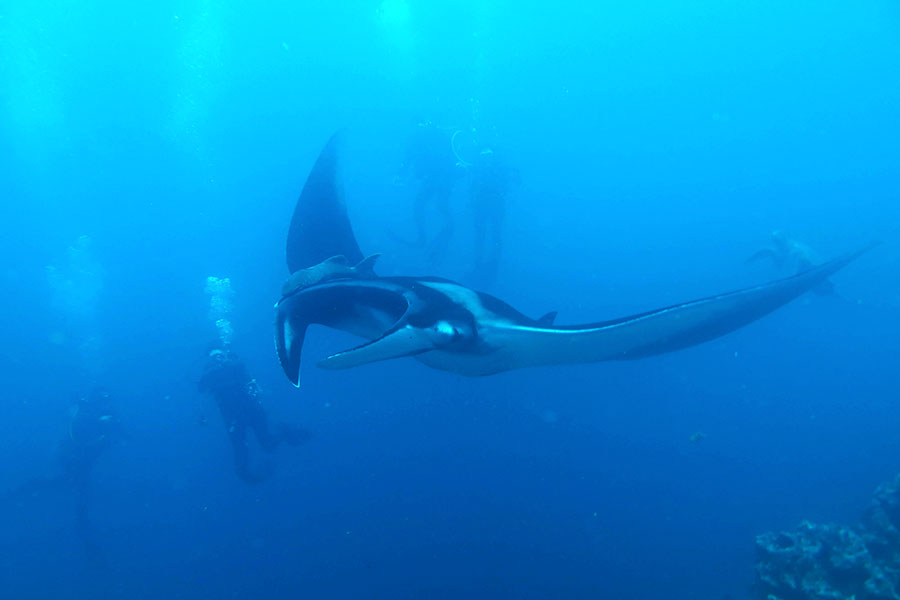The incredible diversity of wildlife found in Galapagos is what makes this volcanic archipelago so special. Above and below the waves of these islands, you can expect a wildlife experience unlike any other.
If you’re wondering what kind of animal encounters you can expect during Galapagos Diving Tours and Daily Galapagos Land Tours, this is the guide for you. Find out more about some of the creatures you may see during your time here.
Do you have any questions for us? Please get in touch for all the answers you need.

An active predator
Like all hammerhead sharks, the scalloped hammerhead is an active predator and gains several advantages from the shape of its head. The widely spaced eyes, nostrils, and other senses allow the scalloped hammerhead to more successfully locate its prey near, or buried in, the sea floor. Also, the scalloped hammerhead may use its head to pin stingrays to the bottom, allowing them to successfully eat those difficult to capture species. Finally, like most sharks, the scalloped hammerhead has special sensory cells that it can use to detect the electric field given off by all other fishes. The wide head likely allows this species to more accurately utilize this sense, again helping it to locate prey buried in the sand.
Unfortunately, scalloped hammerheads have been overfished throughout much of their geographic distribution. Their fins are highly valuable, and their habit of forming regular, large groups makes it easy for fishers to take all of the individuals from a large area by fishing the right place at the right time.
But very shy to people
Though scalloped hammerheads have been implicated (but not confirmed) in biting some people, they are very shy and normally are quite successful at avoiding people. In fact, they can be difficult for scientists to study because they are so shy. Furthermore, they have small mouths relative to their large body size (up to 13 feet/4 m) and do not hunt prey larger than stingrays, so they are unlikely to show aggression toward people.
Distribution: Worldwide in tropical to warm temperate latitudes
Ecosystem/Habitat: Coastal Pelagic
Feeding Habits: Aggressive predator
Conservation Status: Endangered (Highly Vulnerable to Extinction)
Ref: Oceana

Not a ‘true’ seal
The Galapagos sea lion is a species that primarily breeds in the Galapagos Islands, although some breeding colonies also occur on Isla de la Plata just off of mainland Ecuador. They are one of two types of seal found in Galapagos and are part of the eared seal family – having external ear pinnae. They are not ‘true’ seals, as they are able to rotate their hind flipper under their pelvic girdle and lack the characteristic long, finger-like claws of true seals. The configuration of their pelvic girdle allows them to ‘gallop’ across land, reaching speeds exceeding that of a running person on rocky terrain.
The males have a prominent bump on their forehead, making them easy to distinguish from the females. All members of this species have brown or grey fur, females generally being a lighter shade than males, and newborn pups being chestnut brown. The sea lions have a smooth and streamlined body shape, making them efficient hunters, especially of sardines which are their main prey. They can dive to depths up to almost 600 m and can stay underwater for over ten minutes. They spend a lot of their time resting on beaches or playing, and are generally inquisitive.
Males tend to hold territories
The male bulls aggressively defend these territories from other male rivals or interlopers, and the bulls that don’t manage to acquire a territory containing females tend to form bachelor colonies away from the female haul outs. The mating season usually occurs between July and December, but can differ from island to island. After the single pup is born, it bonds with its mother for the first week, developing a unique call to distinguish it from the rest. The mother then starts to forage by day and suckle the pup in the evening, until the fifth week when the pup moults its baby coat and begins to feed inshore. Pups are still dependent on their mothers for the first year of their life, being weaned when they reach eleven to twelve months old.
Distribution: Galapagos Islands and coastal Ecuador
Ecosystem/Habitat: Coastal
Feeding Habits: Aggressive predator
Conservation Status: Endangered

Commonly sighted at many Galapagos dive sites
The Galapagos shark is a species of requiem shark – a family of migratory, live-bearing sharks found in warm waters. Despite its name, the Galapagos shark is found all over the world, but it was first discovered in what is now the Galapagos Marine Reserve. They are quite large for their genus, and have the stereotypically slender, streamlined shark-shaped body. They have 14 rows of serrated teeth that are triangular on the top and sharper on the bottom. Galapagos sharks closely resemble reef sharks and dusky sharks, making them difficult to identify in the field. However their skeletons are very different – the Galapagos shark has 58 vertebrae, whereas dusky sharks have 86-97 vertebrae, and grey reef sharks have 110-119 vertebrae.
Known to be cannibalistic
Galapagos sharks eat primarily benthic bony fish, but in Galapagos they also predate fur seals and sea lions. They have also been known to be cannibalistic, therefore young shark pups tend to stay in shallow inland waters, away from groups of adults. Adult Galapagos sharks are very inquisitive, often showing aggression towards fishermen who try to scare them away. Once they become excited, they are difficult to deter, and when they go into a frenzy they may attack anything floating on the surface of the water. Conversely, they often feel threatened in the presence of divers and some other species of shark, taking on a hunched position.
Distribution: Worldwide in tropical to warm temperate latitudes
Ecosystem/Habitat: Coastal Pelagic
Feeding Habits: Aggressive predator
Conservation Status: Near Threatened
Reaching widths of nearly 11 feet (over 3 m), the spotted eagle ray is one of the largest eagle rays, with only the mantas growing bigger. Spotted eagle rays, like all eagle rays, are active swimmers and do not lie motionless on the seafloor, like the closely related whiptail stingrays (e.g., southern stingray). They are foraging predators and are known to eat a variety of invertebrate and fish prey. Just like the name implies, they are covered in spots and other markings. making them unmistakable with any other species throughout its range.

Also known as sun fish
There are two Mola species that are thought to be found in Galapagos: Mola mola, the ocean sunfish and Mola ramsayi, the southern sunfish. They look very similar and the southern sunfish was only confirmed to visit the Islands through genetic analysis in 2011. They are found throughout the globe, in tropical, sub-tropical and temperature waters as they prefer temperatures at least 10oC – anything colder may cause disorientation. This is probably why they are usually observed basking in the sun, close to the surface, which is where they gained their English name. Their Latin name, Mola, means millstone taken from their rounded body and grey colour.
Odd looking fish
Sunfish are odd looking fish. They have no real tail and propel themselves along using two towring fins, one above and one below. They have thick, tough and rough skin which is almost like sandpaper. Despite their size, they mainly feed on jellyfish, squid, crustaceans and small fish and must consume huge amounts of these to maintain their size. Their teeth are fused in a beak-like structure which allows them to crush the shells of crustaceans, and then food is further ground down by specialised teeth in their throats.
Distribution: Worldwide in tropical to warm temperate latitudes
Ecosystem/Habitat: Open ocean
Feeding Habits: Foraging predator
Conservation Status: Vulnerable
The green turtle is the largest species in the family of hard-shelled sea turtles and second largest to the leatherback turtle among all sea turtles. Its common name comes not from the color of its skin or shell, which is common among most sea turtle species, but from the greenish color of its fat. The green turtle is the only sea turtle that is a strict herbivore, and its diet of seagrass and algae may contribute to the green fatty tissue.

Plankton eaters
The giant manta ray is the largest ray and one of the largest fishes in the world. Reaching widths of up to 23 feet (7 m), the manta rays are much larger than any other ray species. For many decades, there was only one known species of manta, but scientists recently divided that species into two: the giant manta ray, which is a more oceanic species; and the reef manta ray, which is more coastal in nature. Despite their very large size, giant mantas are similar to the largest fishes (whale shark and basking shark) and the largest mammals (blue whale) in that they eat tiny plankton. They constantly swim along with their large mouths open, filtering plankton and other small food from the water. To aid in this strategy, giant mantas have specialized flaps, known as cephalic lobes, which help direct more water and food into their mouths.
Long migrations
Giant mantas are known to undergo long migrations and may visit colder waters for short periods of the year. Although giant mantas are typically solitary animals, they do aggregate to feed and mate. Giant manta rays have one of the lowest fecundity of all elasmobranchs, typically only giving birth to one pup every two to three years. Due to their broad range and sparse distribution across the world’s oceans, there are still gaps in scientists’ knowledge of giant manta ray’s life history. There are reports of giant mantas living to at least 40 years, but little is known about their growth and development.
Distribution: Worldwide in tropical to warm temperate latitudes
Ecosystem/Habitat: Coastal to ocean pelagic
Feeding Habits: Filter feeder
Conservation Status: Vulnerable to Extinction
Ref: Oceana
The largest fish in the world is the graceful, harmless whale shark. Though they reach the size of a school bus, whale sharks eat tiny plankton and fish eggs, which they filter feed as they swim slowly along with their giant mouths wide open. They are one of only three species of filter feeding sharks. Their incredible size may help them to survive long migrations to abundant food sources, between which they may not be able to find enough food. Scientists believe that some individuals swim across entire oceans to arrive just in time for a plankton bloom or a mass spawning of fish or coral eggs – an amazing feat for a fish.